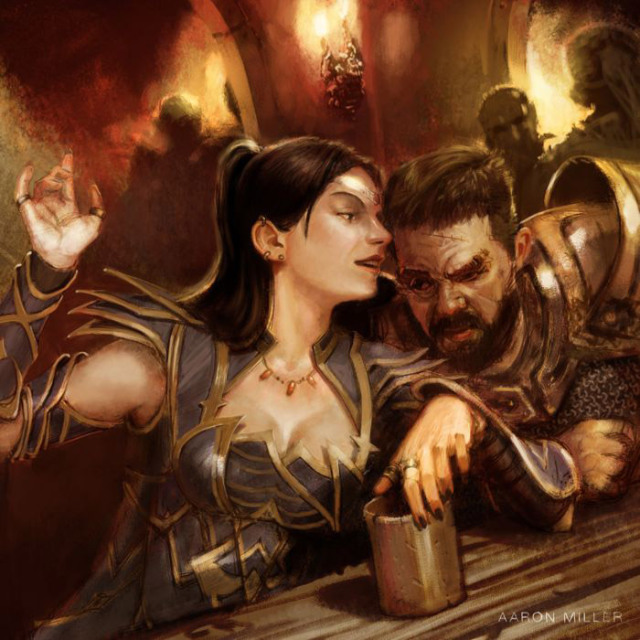
For several years now I have had an ongoing birthday tradition of spending the weekend playing D&D with my brothers and a few close friends. It started, I think, with Dan wanting a longer format to play one of the G-modules (G3 Hall of the Fire Giant King), and now has evolved into a tradition of swapping between the two of us who will run a three day game, punctuated by hanging out on the patio, grilling, swimming, and otherwise taking it easy. It’s a nice counter-point to HelgaCon, being somewhat more relaxed and focused on longer, less rigidly scheduled gaming.
So this year I’m laying plans for being the GM, and I want to inject some elements that I usually reserve for campaign play and would never include in a regular convention game. My first thought was to give them opportunities to leave the dungeon and go back to town, so we could use the carousing table. I’ve posted about carousing so many times I’m not going to go down that path again, instead I’d like to discuss two other tables I’m also thinking of using: rumors and motivations.
Rumor tables are of course an old standard in D&D adventures. Actually I’m now very curious when they first started being used, or in turn what the timeline of module publication in general looks like. That sounds like an interesting research project in its own right. Certainly though I know they appear in many of my favorite modules – Keep on the Borderlands, The Secret of Bone Hill, even Rappan Athuk. I like them best when they’re not purely random and cater to the specific adventure, including little hints as to monsters or treasures that might be found in the dungeon. Their impact can range from light foreshadowing to the creation of specific party goals. I’m not sure I’ve ever seen any written advice for the creation of a rumor table – perhaps it’s worth an appendix to my recent series on dungeon creation to write up a rumor table for it.
Motivation tables are another idea stolen from the excellent Jeff Rients, who originally posted a short d12’s worth on his blog. Paul Vermeren and Bret Wood expanded it to a full 100 entries here. I definitely appreciate the extra content as after rolling on the original 12 a couple times they start to get stale, but I found some of the entries on the expanded table a bit too wacky for my tastes. I like humor in my D&D games, but I prefer it to feel more like Fritz Leiber than Terry Pratchett. For my own use I cut that table in half, pulling out my favorite entries and sprinkling in a few of my own. I indexed it by d100 roll with two numbers per entry for ease of use. You can grab it here if you’d like.
For both of these tables, the problem I face is when and how much to use them. Rumor tables, by virtue of being custom made for each adventure, are often light on rules for when to hand them out. I like having the players roll for them randomly, possible impacted by their charisma score, but I’d be disappointed if none got handed out due to bad rolling. What the range of an acceptable number to hand out does vary by the size of the table, but I’ve tended recently towards one per player base plus a chance at some extra for a high charisma (eg. roll a number of d6’s equal to your charisma bonus, get an extra rumor on any 4’s or better).
The motivation table gives even less guidance. Rients humorously proposes using it only in reaction to a player demanding to know why their character would bother with the adventure at all. This use has come for me exactly once, and while it is quite funny to see the surprise on the players face when you respond by making them roll on a table, I’d kind of rather have some assurance of getting to use it at all. On the other hand, I think if you had every single player at the table roll at the start of a game, it might be overkill.
One thought that struck me, since these are both pre-adventure tables, is to give the option to the players. Each player may choose to make one free roll on either the motivation or rumor table at the start of the game. Perhaps that would generate a good mix of hints, goals, and personal motives to seed the party with some interesting dynamics before they head out? Right now I kind of like that idea, perhaps I’ll give it a try at my birthday and see how it goes.



There’s actually a rule for “Rumors, Information, and Legends” baked into the original D&D LBBs (Vol-3, p. 23); in brief: “FY, pay me” (10-60 gp). So in my current campaign I appended that to the goods-for-sale list, and rule that you get one rumor per such payment, and have a rumor table much like B2. However: _somebody_ convinced the rest of the party it wasn’t worthwhile to use it (after one roll)…
Caveat: Still low level, but if the price stays the same, in theory a high-level adventurer could splash 1,000 gp out and scoop up every available rumor, I suppose.
That’s pretty neat! Information as equipment, essentially.
Also, argh! I hate when players chicken out and pass up on a potentially useful resource like that. I’ve always felt the Carousing rules suffer from that sort of turtling behavior. The point of the game is to PLAY it, not just accumulate numbers on your frikkin’ character sheet.